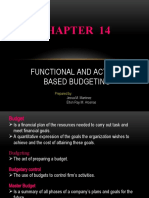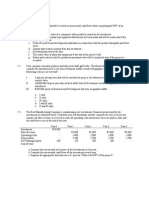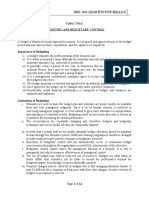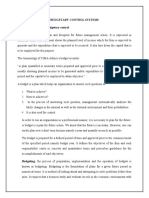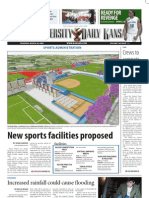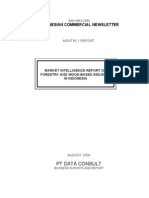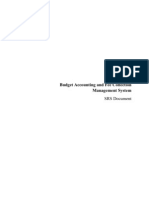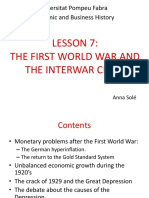8 - BU D GE T A R Y C ON T R OL: Definition
8 - BU D GE T A R Y C ON T R OL: Definition
Uploaded by
vjain_229353Copyright:
Available Formats
8 - BU D GE T A R Y C ON T R OL: Definition
8 - BU D GE T A R Y C ON T R OL: Definition
Uploaded by
vjain_229353Original Description:
Original Title
Copyright
Available Formats
Share this document
Did you find this document useful?
Is this content inappropriate?
Copyright:
Available Formats
8 - BU D GE T A R Y C ON T R OL: Definition
8 - BU D GE T A R Y C ON T R OL: Definition
Uploaded by
vjain_229353Copyright:
Available Formats
MASTER MINDS - QUALITY EDUCATION BEYOND YOUR IMAGINATION
1. DEFINE THE TERM BUDGET.
8 . BU D GE T A R Y C ON T R OL
Definition:
Bu dge t is a financial and /or quantitative statement, prepared and appr ove d prior to a defined Period of time of the policy to be pursued during that period for the purp ose of attaining a given objective. It may inclu de incom e, expe nditur e and employment of capital.
Features:
1. 2. 3. 4. Financial Statement. Futuristic Goa l Oriented Components and/ or Quantitative
prepared and approved prior to a defined period of time. for the purp ose of attaining a given objective. Income, Expenditure and Employment of Capital. BUDGETING?
2. WHAT ARE THE OBJECTIVES OF BUDGETING/PERFORMANCE The objectives of Budgeting are
1. To encourage self study in all aspec ts of a Co mpany' s operations. 2. To get all membe rs of management to put their heads to the basic question of how t he business should be run, to make them of a coordinated team operating in uni son towa rds clearly defined obj ectiv es. 3. To promote the planning organization. 4. To force a definition and pro cess and provide a sense of direction and aims. to every member of the
crystalli zation of Company policies
5. To increase the effectiveness with which people and capital are employed. 6. To disclose areas of potential improvement in the Companys operations. economic environment for
7. To stimulate study of relationship of the Co mp any to its external improving the effectiveness of its direction.
8. To direc t and coordinate business activities and units to achieve stated targets of performance. 9. To facilitate the control process , by com pari ng actual results with plan, and provide feedback to the employees about their perform ance . 3. DEFINE THE TERM BUDGETARY CONTROL. WHAT ARE ITS SALIENT FEATURES? 1. Definition : Budgetary Co ntrol is defined as "the establishment of budgets, relating the responsibilities of executives to the requirements of a policy, and the continuous com parison of actual with bud geted results either to secure by individual action the objec tive of that policy or to provide a base for its revision. 2. Salient features: a. Objectives: Determinin g the objectiv es to be achieved, over the budget period, and the policy (ies) that might be adopted for the achievement of these ends. b. Activities: Determinin g the variety of activities that should be undertaken for achievement the objectives. c. of
Plans: Drawing up a plan or a sche me of opera tion in res pect of each cla ss of activity, in physical a well as monetary terms for the full budge t period and its parts.
d. Performance Evaluation: Laying out a system of compari son of actual perform ance by each person sec tion or department with the releva nt budget and dete rminati on of causes for the disc repancies, if any. e. Control Action: Ensuring that when the plans are not achieved, corrective action are taken and when cor rective actions are not possible, ensuring that the plans are revise d and objectiv e achieved
Budgetary Control____
___
_8.1
MASTER MINDS - QUALITY EDUCATION BEYOND YOUR IMAGINATION
4. WHAT ARE THE OBJECTIVES OF BUDGETARY CONTROL SYSTEM? The objectives of a Budgetary Control System are 1. Definition of Goals: Portraying with precision, the overall aims of the business and dete rmini ng targ ets of performance for each sec tion or department of the business. 2. Defining Responsibilities: Laying down the responsibiliti es of each individual knows what is expected of him and how he will be judge d. so that eve ryon e
3. Basis for Performance Evaluation: Providing basis for the compari son of actual performan ce with the predetermined targ ets and investigation of deviation, if any, of actu al perform ance and expenses from the budgeted figures. It helps to take timely corr ective measures. 4. Optimum use of Resources: Ensuring the best use of all available res ourc es to maximize profit or production, subject to the limiting factors. 5. Co ordination: Coordinating the various activities of the business and centralizing control, but also makin g a facility for the Management to decentralize resp onsibility and delegate authority. 6. Planned action: Engendering a spirit of care ful forethought, asses sment of what is possible and an attempt at it. It leads to dynamism without recklessness . It also helps to draw up long ran ge plan s with a fair measure of accuracy. 7. Basis for policy: Providing a basis for revision of current and futu re policies. 5. WHAT ARE THE DISADVANTAGES/LIMITATIONS OF THE BUDGETARY CONTROL SYSTEM?
1. Estimates: Bu dge ts may or may not be true, as they are base d on estimates . The ass umptions about futu re events may or may not actually happen . 2. Rigidity: Budgets are considered as rigid document. Too mu ch emphas is on budgets may affect daytod ay operations and ignores the dynamic state of organizational fun ctioning. 3. False Sense of Security: Mere budgeting canno t lead to profitability. Budgets cannot be executed automatically. It may create a false sense of security that everything has bee n taken care of in the budgets. 4. Lack of coordination: Staff cooperation is usually not ava ilable durin g Budge tar y Co ntrol exercise. and imp lement ation of the system may be expensive.
5. Time and Cost: The introduction
6. WHAT ARE THE DIFFERENT TYPES OF BUDGETS? DISTINGUISH BETWEEN FIXED AND FLEXIBLE BUDGETS. Budgets may be classified on the following base s 1. TimePeriod 2. Conditions 3. Capacity 4. Coverage
a. Longterm Budget & b. Short term Budget a.
b. Basic Budget and c. Current Budget a.
b. Fixed Bu dge t and c. Flexible Budget a.
b. Functional Bud get and c. Maste r Budget
1. BASED ON TIME PERIOD: Long Term Budget Short Term Budget
Budgetary Control____
___
_8.2
IMAGINATION a. Budgets which are prepared for periods longe r than a year are called Long Term Budgets. b. Such Bud gets are helpful in business forecasting and forward plannin g. c. Examples: Capital Expenditure Bu dge t and R&D Budget.
MASTER MINDS - QUALITY EDUCATION BEYOND YOUR
a. Budgets which are prepared for periods less than a yea r are known as Short Term Budgets. b. Such Bud gets are prepared in cases where a spe cifi c action has to be immediately taken to brin g any variation und er control. c. Example: Cash Budget.
Budgetary Control____
___
_8.3
You might also like
- Econ 11 ReviewerDocument6 pagesEcon 11 ReviewerfronstmonsterzzNo ratings yet
- Chapter 13 Budgets and Budgetary ControlDocument47 pagesChapter 13 Budgets and Budgetary ControlAndrew StarkNo ratings yet
- Budgetary Contro1Document138 pagesBudgetary Contro1shubham singhNo ratings yet
- Functional and Activity - Based BudgetingDocument45 pagesFunctional and Activity - Based BudgetingJessa MartinezNo ratings yet
- NPV & Capital Budgeting QuestionsDocument8 pagesNPV & Capital Budgeting QuestionsAnastasiaNo ratings yet
- Budgetary ControlDocument33 pagesBudgetary ControlAsif0786No ratings yet
- Chapter 7. Budget and Quantitative techniques DecDocument15 pagesChapter 7. Budget and Quantitative techniques DechapfyNo ratings yet
- Chapter 7. Budget and Quantitative techniques DecDocument16 pagesChapter 7. Budget and Quantitative techniques DechapfyNo ratings yet
- Chapter 8 BudgetDocument17 pagesChapter 8 Budgetangeloumali42No ratings yet
- 14 Fgfgfgdsdcontrol TheoryDocument40 pages14 Fgfgfgdsdcontrol TheoryDeepak R GoradNo ratings yet
- BugetingDocument12 pagesBugetinganamasih141993No ratings yet
- Budgetary Control of IndiaDocument30 pagesBudgetary Control of IndiaNiks DujaniyaNo ratings yet
- Perfomance BudjectingDocument72 pagesPerfomance BudjectingAnithaNo ratings yet
- Mcom-1 Project Budgetary ControlDocument39 pagesMcom-1 Project Budgetary ControlMishti Red100% (1)
- Metalanguage: Big Picture in Focus: Ulod. Understand The Budgeting Framework and Develop A Master BudgetDocument5 pagesMetalanguage: Big Picture in Focus: Ulod. Understand The Budgeting Framework and Develop A Master BudgetJeson MalinaoNo ratings yet
- Budget: Submitted By:-JappanjyotDocument16 pagesBudget: Submitted By:-JappanjyotJappanJyot Kalra100% (1)
- Ready Project B&BCDocument39 pagesReady Project B&BCDaddy's Li'll Angel RuchiNo ratings yet
- BHMCT Sem VII Spl. Front Office Mgt. II CED 701 Chapter 3Document6 pagesBHMCT Sem VII Spl. Front Office Mgt. II CED 701 Chapter 3neelsequeira.9No ratings yet
- BUDGETING 14 AprilDocument13 pagesBUDGETING 14 AprilMayank MalhotraNo ratings yet
- Ty - Baf. Sem Vi Cost-1Document31 pagesTy - Baf. Sem Vi Cost-1Nilesh DaveNo ratings yet
- HRD 104 - QS Ii Topic Two (Budgeting) NotesDocument14 pagesHRD 104 - QS Ii Topic Two (Budgeting) NotesFidel FlavinNo ratings yet
- PLANNING AND CONTROL SYSTEM-may 2021Document10 pagesPLANNING AND CONTROL SYSTEM-may 2021Seyon HunpeganNo ratings yet
- Unit 2 Budget and Budgetary Control - 8601574734764214Document82 pagesUnit 2 Budget and Budgetary Control - 8601574734764214Rhea Mae AmitNo ratings yet
- MGNT Acc Module - VDocument10 pagesMGNT Acc Module - Vsuduh09No ratings yet
- Budgeting: Joanna Jane F. Ang, RNDocument15 pagesBudgeting: Joanna Jane F. Ang, RNJoanna Jane AngNo ratings yet
- Budgetary ControlDocument24 pagesBudgetary ControlSapna MalikNo ratings yet
- Seminar On: Budget Estimate, Revised Budget and Performance Budget)Document12 pagesSeminar On: Budget Estimate, Revised Budget and Performance Budget)Reshma AnilkumarNo ratings yet
- Seminar On: Budget Estimate, Revised Budget and Performance Budget)Document12 pagesSeminar On: Budget Estimate, Revised Budget and Performance Budget)Reshma AnilkumarNo ratings yet
- Topic 6.2 - Budgets & ForecastsDocument4 pagesTopic 6.2 - Budgets & Forecastsmundubijohn1No ratings yet
- Unit-5 - Budgets and Budgetory ControlDocument28 pagesUnit-5 - Budgets and Budgetory ControlCoimbatore foodieNo ratings yet
- MaaDocument2 pagesMaaSiva SankariNo ratings yet
- Budgetary ControlDocument18 pagesBudgetary ControlTeena VarmaNo ratings yet
- Ch06 Master Budget and Responsibility AccountingDocument11 pagesCh06 Master Budget and Responsibility AccountingChaituNo ratings yet
- BudgetingDocument19 pagesBudgetingmaakkanNo ratings yet
- BudgetDocument12 pagesBudgetSukruth SNo ratings yet
- Serviano Pfe4 Ma2 Midterm Module Ivisan Bsa3 AbDocument19 pagesServiano Pfe4 Ma2 Midterm Module Ivisan Bsa3 AbMELVIN ABADANo ratings yet
- The Concept and Objectives of Budgets April2 86Document6 pagesThe Concept and Objectives of Budgets April2 86Teererai KaguraNo ratings yet
- Name:-Yoseph Berhane Section: - ADocument3 pagesName:-Yoseph Berhane Section: - Ayoseph berhaneNo ratings yet
- Lesson 10 - Financial ManagementDocument8 pagesLesson 10 - Financial ManagementLand DoranNo ratings yet
- 336Document4 pages336Dah NEPALNo ratings yet
- Budget and Budgetary ControlDocument78 pagesBudget and Budgetary ControlDavid Abbam AdjeiNo ratings yet
- BUDGETING PresentationDocument6 pagesBUDGETING PresentationJandJ's Art BoxNo ratings yet
- Budgeting Latest For SpecializationDocument49 pagesBudgeting Latest For SpecializationJahanzaib ButtNo ratings yet
- Budgeting Introduction PartDocument8 pagesBudgeting Introduction PartAvinash kashimNo ratings yet
- Managerial Accounting Asiacareer College/Cparcenter Operational and Financial Budgeting DWM - Reyno, Cpa, DbaDocument3 pagesManagerial Accounting Asiacareer College/Cparcenter Operational and Financial Budgeting DWM - Reyno, Cpa, DbaCertified Public AccountantNo ratings yet
- Budget Budgetary ControlDocument33 pagesBudget Budgetary ControlAnirban BiswasNo ratings yet
- Budgets and Their Ability To Support Organisational ObjectivesDocument38 pagesBudgets and Their Ability To Support Organisational ObjectivesranjithNo ratings yet
- Theories and Principles of Educational ManagementDocument17 pagesTheories and Principles of Educational ManagementPatrizzia Ann Rose OcbinaNo ratings yet
- BSM PG College Roorkee: Assignment On AuditingDocument42 pagesBSM PG College Roorkee: Assignment On AuditingNeeraj Singh RainaNo ratings yet
- Budgetry ControlDocument61 pagesBudgetry ControlPranav Shandil100% (1)
- BudgetingDocument20 pagesBudgetingSanjeevNo ratings yet
- M4 Budgeting For Profit and ControlDocument8 pagesM4 Budgeting For Profit and Controlwingsenigma 00No ratings yet
- Esg Budget Management Final VersionDocument66 pagesEsg Budget Management Final Versionrita tamohNo ratings yet
- BudgetsDocument35 pagesBudgetsMayank Pande100% (1)
- Stages of Business PlanningDocument21 pagesStages of Business PlanningArnel De Los Santos100% (1)
- Lecture 7 BudgetDocument7 pagesLecture 7 BudgetDaryna565No ratings yet
- 2020 PDFDocument39 pages2020 PDFNeeraj Singh RainaNo ratings yet
- BSM PG College Roorkee: Assignment On AuditingDocument39 pagesBSM PG College Roorkee: Assignment On AuditingNeeraj Singh RainaNo ratings yet
- Vipul2 PDFDocument39 pagesVipul2 PDFNeeraj Singh RainaNo ratings yet
- LEAD TOPICSDocument26 pagesLEAD TOPICSsadhikapra25No ratings yet
- Master Budgeting and Forecasting for Hospitality Industry-Teaser: Financial Expertise series for hospitality, #1From EverandMaster Budgeting and Forecasting for Hospitality Industry-Teaser: Financial Expertise series for hospitality, #1No ratings yet
- Health Financing Overview-1Document15 pagesHealth Financing Overview-1Lydia ladislausNo ratings yet
- 2009-03-26Document20 pages2009-03-26The University Daily KansanNo ratings yet
- Utility Maximization and ChoiceDocument40 pagesUtility Maximization and ChoiceBella Novitasari100% (1)
- Forest and Wood-Based Industry in Indonesia - 20866Document96 pagesForest and Wood-Based Industry in Indonesia - 20866ulla_miners100% (1)
- Accounting For Public Sector Chap 2Document71 pagesAccounting For Public Sector Chap 2fekadegebretsadik478729No ratings yet
- A Budget Is A Plan of What The Organization Is Aiming To Achieve and What It Has Set As A TargetDocument17 pagesA Budget Is A Plan of What The Organization Is Aiming To Achieve and What It Has Set As A TargetDEODATUSNo ratings yet
- Ipsas-24-Presentation-Of BudgetDocument31 pagesIpsas-24-Presentation-Of BudgetlilorbitsbatscityNo ratings yet
- Book 2Document2 pagesBook 2Khang TrầnNo ratings yet
- Departmental Code DGMDocument25 pagesDepartmental Code DGMChamu PhaniNo ratings yet
- 5 6201958407788822731Document23 pages5 6201958407788822731Ugyen ThinleyNo ratings yet
- Cash BudgetDocument2 pagesCash BudgetanupsuchakNo ratings yet
- Eschool Ela Career Development Unit 3-Module 1 Resource 2 - Analyze BudgetDocument2 pagesEschool Ela Career Development Unit 3-Module 1 Resource 2 - Analyze Budgetapi-513599248No ratings yet
- 11 Project Management PDFDocument4 pages11 Project Management PDFSaiful Islam SumonNo ratings yet
- Capital BudgetingDocument6 pagesCapital BudgetingJaylin DizonNo ratings yet
- Unit 4 BudgetDocument11 pagesUnit 4 BudgetAravind AbimaniyuNo ratings yet
- FMMA Vol 01 PDFDocument117 pagesFMMA Vol 01 PDFMuhammad Ahmad50% (2)
- Facing Interview PDFDocument358 pagesFacing Interview PDFRakesh Baylan100% (1)
- Rancangan Perniagaan PhotoshopDocument66 pagesRancangan Perniagaan PhotoshopMohamad Khairul NizamNo ratings yet
- Sap FM 001Document35 pagesSap FM 001RakeshNo ratings yet
- Srs Budget AccountingDocument27 pagesSrs Budget AccountingDivya Sharma100% (1)
- HCM 400 Final ProjectDocument9 pagesHCM 400 Final ProjectEunice AppiahNo ratings yet
- Lecture 9 Fiscal PolicyDocument53 pagesLecture 9 Fiscal PolicyAmjid HussainNo ratings yet
- 35-PublicFinanceManagement CountyGovernments Regulations2015 PDFDocument96 pages35-PublicFinanceManagement CountyGovernments Regulations2015 PDFtom nyatikaNo ratings yet
- Growing Centralisation of Social Sector Policies in IndiaDocument9 pagesGrowing Centralisation of Social Sector Policies in IndiaSudhir SinghNo ratings yet
- Cap BudgetingggDocument3 pagesCap BudgetingggSiva SankariNo ratings yet
- Naveed Abbas Rana, Cpa: Rief RofileDocument2 pagesNaveed Abbas Rana, Cpa: Rief RofileNaveed A RanaNo ratings yet
- Lesson 7: The First World War and The Interwar CrisisDocument45 pagesLesson 7: The First World War and The Interwar Crisisupf123No ratings yet



